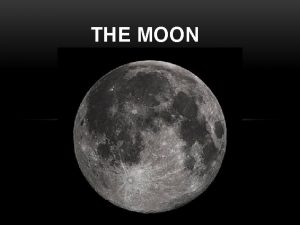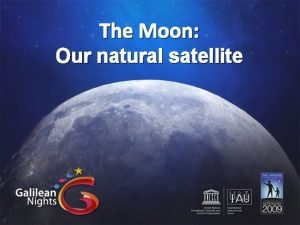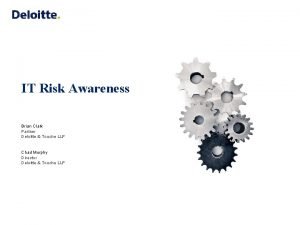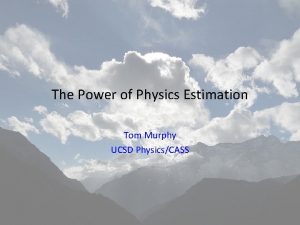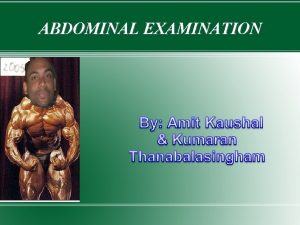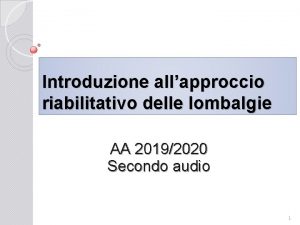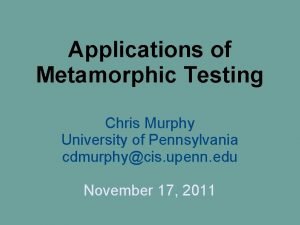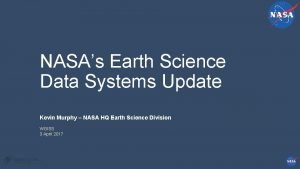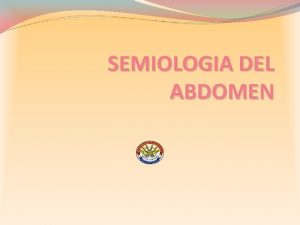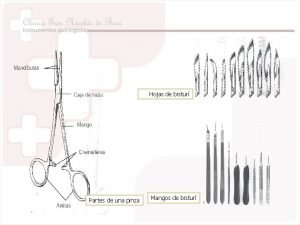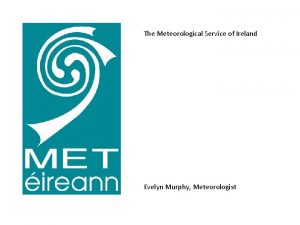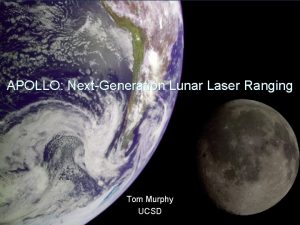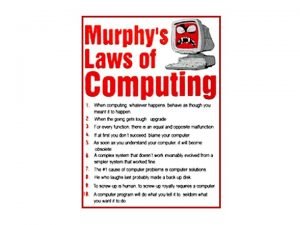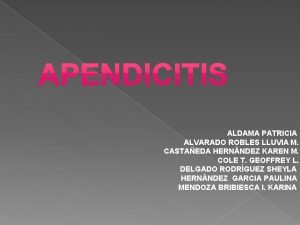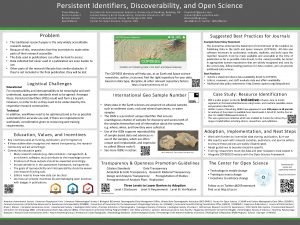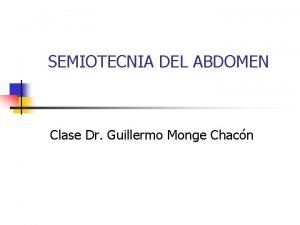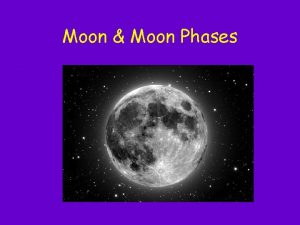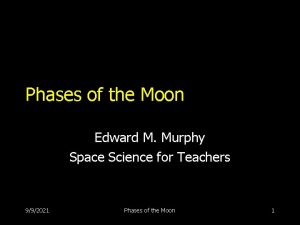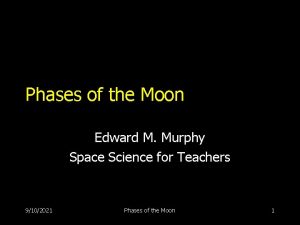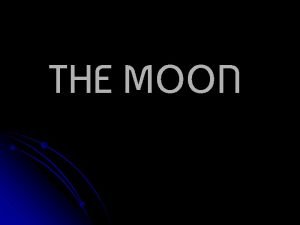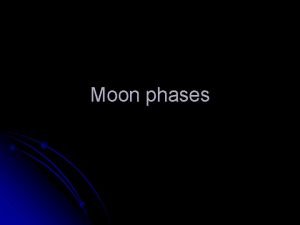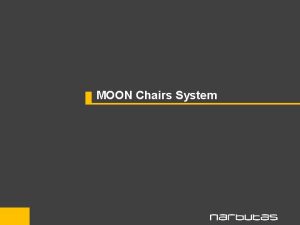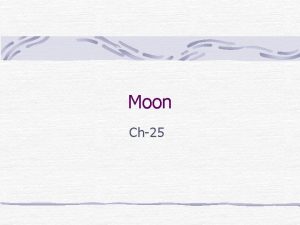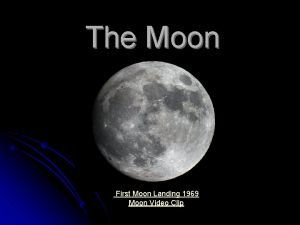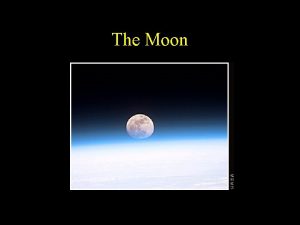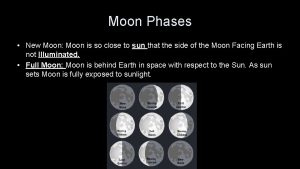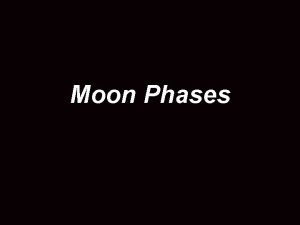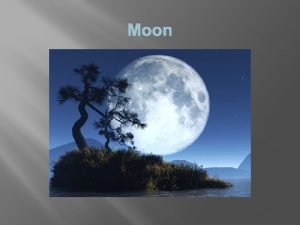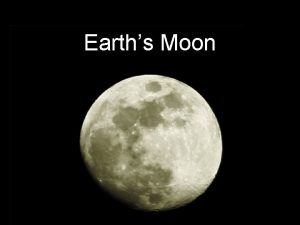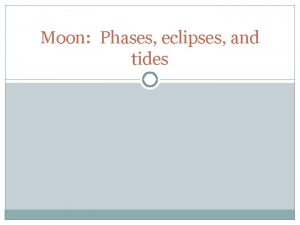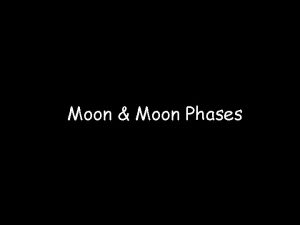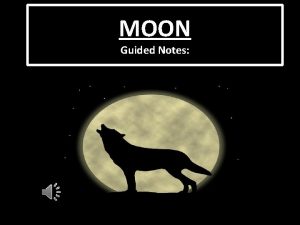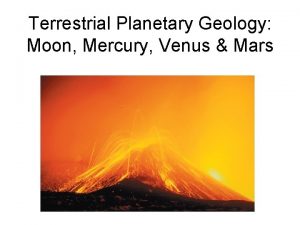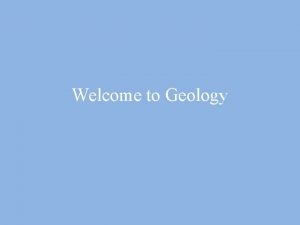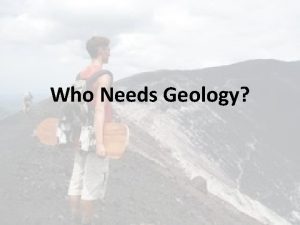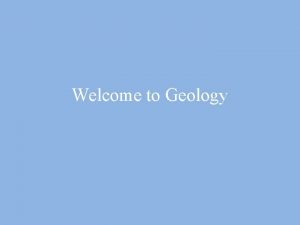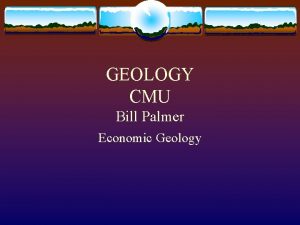Geology of the Moon Edward M Murphy Department



















































- Slides: 51

Geology of the Moon Edward M. Murphy Department of Astronomy University of Virginia 3/6/2021 The Geology of the Moon 1

3/6/2021 The Geology of the Moon 2

3/6/2021 The Geology of the Moon 3

Lunar Geology • The near side of the Moon is dominated by two types of terrain. – The maria (singular mare) are smooth, dark lava flows that cover 17% of the Moon. – The brighter highlands (terrae) which are completely covered in craters. 3/6/2021 The Geology of the Moon 4

3/6/2021 The Geology of the Moon 5

Grand Teton National Park, Wyoming 3/6/2021 The Geology of the Moon 6

Blue Ridge Mountains, North Carolina 3/6/2021 The Geology of the Moon 7

Age of the Lunar Surface • The amount of cratering can be used to determine the age of the parts of the lunar surface. – The highlands have many more impact craters which means that they have been exposed to space longer (that is, they are older) than the maria. – Scientists can count the number of craters per square km and use that to determine the age of the surface. 3/6/2021 The Geology of the Moon 8

3/6/2021 The Geology of the Moon 9

Mare Imbrium lava flow 3/6/2021 The Geology of the Moon 10

Basalt lava flow, Hawaii 3/6/2021 The Geology of the Moon 11

Highlands 3/6/2021 The Geology of the Moon 12

Lunar Far Side 3/6/2021 The Geology of the Moon 13

Impact Cratering • Impact Craters are created when meteoroids, asteroids, and comets strike the moon. – The objects are typically traveling 10 -20 km/s. – Very roughly, the crater is usually about 10 times the diameter of the impactor. 3/6/2021 The Geology of the Moon 14

Cratering 3/6/2021 The Geology of the Moon 15

Ejecta blanket Eratosthenes Central peak Raised Rim, Terraced Walls Copernicus Secondary craters 3/6/2021 The Geology of the Moon 16

Impact Basin 3/6/2021 The Geology of the Moon 17

Orientale Basin 3/6/2021 The Geology of the Moon 18

Mare Orientale 3/6/2021 The Geology of the Moon 19

Why Doesn’t the Earth Lokk Like This? 3/6/2021 The Geology of the Moon 20

Great Meteor Crater 3/6/2021 The Geology of the Moon 21

Great Barringer Meteor Crater • • Located in Arizona Age 49 3 thousand years Diameter 1. 2 km Created by an iron/nickel meteoroid 120 -150 feet across traveling at 7 miles per second. 3/6/2021 The Geology of the Moon 22

Manicougan Crater 3/6/2021 The Geology of the Moon 23

Manicougan Crater • Located in Quebec, Canada • Age 214 1 million years • Diameter 100 km 3/6/2021 The Geology of the Moon 24

Clearwater, Quebec Canada 3/6/2021 The Geology of the Moon 25

Chicxulub Crater 3/6/2021 The Geology of the Moon 26

Chicxulub Crater 3/6/2021 The Geology of the Moon 27

3/6/2021 The Geology of the Moon 28

Chicxulub Crater • Located in Yucatan, Mexico • Age 64. 98 0. 05 million years • Diameter of 170 km 3/6/2021 The Geology of the Moon 29

Chesapeake Bay 3/6/2021 The Geology of the Moon 30

Chesapeake Bay • Located in Virgina, USA • Age 35. 5 0. 6 million years • Diameter of 85 km 3/6/2021 The Geology of the Moon 31

North American Impact Craters 3/6/2021 The Geology of the Moon 32

Vredefort Crater 3/6/2021 The Geology of the Moon 33

3/6/2021 The Geology of the Moon 34

Vredefort Impact Crater • The Vredefort Crater in South Africa is the largest remaining impact crater on the Earth. • Age 2. 023 0. 004 billion years • Diameter 300 km 3/6/2021 The Geology of the Moon 35

3/6/2021 The Geology of the Moon 36

3/6/2021 The Geology of the Moon 37

3/6/2021 The Geology of the Moon 38

3/6/2021 The Geology of the Moon 39

3/6/2021 The Geology of the Moon 40

3/6/2021 The Geology of the Moon 41

3/6/2021 The Geology of the Moon 42

Im Au Ar Ap E C 3/6/2021 The Geology of the Moon 43

3/6/2021 The Geology of the Moon 44

3/6/2021 The Geology of the Moon 45

3/6/2021 The Geology of the Moon 46

An area centered about 900 km southeast of the Imbrium basin, illustrating the radial fracturing and sculpturing of terra materials by the basin forming event. The arrow points to a 120 km long fracture that cuts the rims of the partly visible crater Albategnius in the lower left of the photograph and the crater Halley toward the upper left. It and similar trending fractures elsewhere in this picture are radial to the Imbrium basin and are related to its formation. The crater Hipparchus C (HC) is superposed on a fracture and, therefore, is younger than the Imbrium basin and the Imbrium sculpture. Light plains forming materials (LP) are younger than the Imbrium event, as indicated by the absence of fractures and the scarcity of superposed craters. Light plains deposits are a major stratigraphic unit of the terra regions. 3/6/2021 The Geology of the Moon 47

3/6/2021 The Geology of the Moon 48

3/6/2021 The Geology of the Moon 49

Lunar History Time in past (aeons ago) Event 4. 5 Accretion of Moon in Earth Orbit 4. 5 -4. 2 Differentiation of crust and mantle; plutonism, volcanism, impact mixing and melting. 4. 2 Crustal solidification and formation of oldest preserved basins. 4. 2 -3. 92 Formation of at least 30 pre-Nectarian basins 3. 92 Nectaris basin impact, beginning Nectarian Period 3. 92 -3. 84 Formation of 10 Nectarian basins, including Serenitatis and Crisium 3. 84 Imbrium basin impact, eruption of oldest dated intact mare lava flows, beginning Imbrian Period 3. 8 Formation of last large basin (Orientale), marking Early Imbrian-Late Imbrian boundary. 3/6/2021 The Geology of the Moon 50

Lunar History Time in past (aeons ago) Event 3. 8 -3. 2 Eruption of most voluminous mare lavas and pyroclastics; continued diminished impact cratering 3. 2 Imbrian-Eratosthenian Period boundary 3. 2 -1. 1 Continued mare volcanism and impact cratering 1. 1 Eratosthenian-Copernican Period boundary 0. 81 Copernicus impact 0. 11 Tycho impact 3/6/2021 The Geology of the Moon 51
 Department of geology university of dhaka
Department of geology university of dhaka Home.hiwaay.net/ krcool/astro/moon/moon tides/
Home.hiwaay.net/ krcool/astro/moon/moon tides/ Duo servicekantoor
Duo servicekantoor Moons pattern
Moons pattern Which moon phase occurs directly before a new moon
Which moon phase occurs directly before a new moon Moon sister moon calendar
Moon sister moon calendar Pefht
Pefht Atkins and murphy reflective model
Atkins and murphy reflective model Murphy and peck
Murphy and peck Brian murphy deloitte
Brian murphy deloitte Charcot's triad
Charcot's triad Murphy schmidt solicitors
Murphy schmidt solicitors Murphy junior high
Murphy junior high Tom murphy do the math
Tom murphy do the math Murphy battista
Murphy battista Quem crer em mim
Quem crer em mim Murphy's sign
Murphy's sign Tim murphy ubc
Tim murphy ubc Cause sudorazione notturna
Cause sudorazione notturna Chris murphy upenn
Chris murphy upenn Kevin murphy nasa
Kevin murphy nasa Joseph murphy vanderbilt
Joseph murphy vanderbilt Maniobra de la mano de escultor de merlo
Maniobra de la mano de escultor de merlo Marybeth murphy stevens institute
Marybeth murphy stevens institute Alejandro piscitelli murphy
Alejandro piscitelli murphy Separador jackson
Separador jackson Mark murphy hundred percenters
Mark murphy hundred percenters Arlene murphy
Arlene murphy Murphyschmidt
Murphyschmidt Renee murphy forrester
Renee murphy forrester Abdominal splash
Abdominal splash Mya eve murphy
Mya eve murphy En qué consiste la ley de murphy
En qué consiste la ley de murphy Meteorologist ireland
Meteorologist ireland Pathological generals in repertory
Pathological generals in repertory Tom murphy ucsd
Tom murphy ucsd Murphy's computer law
Murphy's computer law Germaine pagnol
Germaine pagnol Signo dumphy
Signo dumphy When and why was ross barnett elected governor?
When and why was ross barnett elected governor? Electronic rostering
Electronic rostering Colelitiasis
Colelitiasis Papa murphy's employee handbook
Papa murphy's employee handbook Cronologia de murphy
Cronologia de murphy Kevin murphy color wheel
Kevin murphy color wheel Joseph murphy vanderbilt
Joseph murphy vanderbilt Charcot triadı
Charcot triadı Dr nichole mellor
Dr nichole mellor Maniobra de middleton
Maniobra de middleton Margaret murphy patient advocate
Margaret murphy patient advocate Meleah murphy
Meleah murphy Weed control murphy
Weed control murphy



